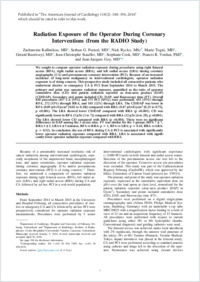Radiation exposure of the operator during coronary interventions (from the RADIO Study)
- Kallinikou, Zacharenia Department of Cardiology, Hospital and University of Fribourg, Switzerland
- Puricel, Serban G. Department of Cardiology, Hospital and University of Fribourg, Switzerland
- Ryckx, Nick Department of Radiology, Institute of Radiophysics, Centre Hospitalier Universitaire Vaudois, Lausanne, Switzerland
- Togni, Mario Department of Cardiology, Hospital and University of Fribourg, Switzerland
- Baeriswyl, Gerard Department of Cardiology, Hospital and University of Fribourg, Switzerland
- Stauffer, Jean-Christophe Department of Cardiology, Hospital and University of Fribourg, Switzerland
- Cook, Stéphane Department of Cardiology, Hospital and University of Fribourg, Switzerland
- Verdun, Francis R. Department of Radiology, Institute of Radiophysics, Centre Hospitalier Universitaire Vaudois, Lausanne, Switzerland
- Goy, Jean-Jacques Department of Cardiology, Hospital and University of Fribourg, Switzerland
-
15.07.2016
Published in:
- The American Journal of Cardiology. - 2016, vol. 118, no. 2, p. 188–194
English
We sought to compare operator radiation exposure during procedures using right femoral access (RFA), right radial access (RRA), and left radial access (LRA) during coronary angiography (CA) and percutaneous coronary intervention (PCI). Because of an increased incidence of long-term malignancy in interventional cardiologists, operator radiation exposure is of rising concern. This prospective study included all consecutive patients who underwent elective or emergency CA ± PCI from September 2014 to March 2015. The primary end point was operator radiation exposure, quantified as the ratio of operator cumulative dose (CD) and patient radiation reported as dose-area product (DAP) (CD/DAP). Secondary end points included CD, DAP, and fluoroscopy time (FT). Overall 830 procedures (457 CA [55%] and 373 PCI [45%]) were performed, 455 (55%) through RFA, 272 (33%) through RRA, and 103 (12%) through LRA. The CD/DAP was lower in RFA (0.09 μSv/Gycm² [0.02 to 0.20]) compared with RRA (0.47 μSv/Gycm² [0.25 to 0.75], p <0.001). The LRA showed lower CD/DAP compared with RRA (p <0.001). CD was significantly lower in RFA (3 μSv [1 to 7]) compared with RRA (12 μSv [6 to 29], p <0.001). The LRA showed lower CD compared with RRA (p <0.001). There were no significant differences in DAP among the 3 access sites. FT was similar for the 3 groups (RFA 7 ± 7, RRA 5 ± 5, LRA 6 ± 5 minutes, RFA vs RRA: p = 1, RFA vs LRA: p = 0.16, RRA vs LRA: p = 0.52). In conclusion, the use of RFA during CA ± PCI is associated with significantly lower operator radiation exposure compared with RRA. LRA is associated with significantly lower operator radiation exposure compared with RRA.
- Faculty
- Faculté des sciences et de médecine
- Department
- Médecine 3ème année
- Language
-
- English
- Classification
- Biological sciences
- License
- License undefined
- Identifiers
-
- RERO DOC 277706
- DOI 10.1016/j.amjcard.2016.04.045
- Persistent URL
- https://folia.unifr.ch/unifr/documents/305188
Statistics
Document views: 76
File downloads:
- tog_reo.pdf: 211
